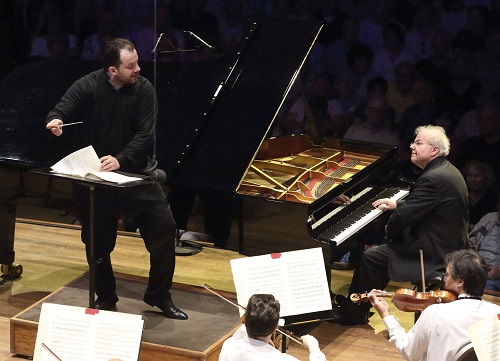 United States 2019 Tanglewood Music Festival [3] – Mozart, Mahler: Emanuel Ax (piano), Boston Symphony Orchestra / Andris Nelsons (conductor), Koussevitzky Shed, Tanglewood, 5.7.2019. (CSa)
United States 2019 Tanglewood Music Festival [3] – Mozart, Mahler: Emanuel Ax (piano), Boston Symphony Orchestra / Andris Nelsons (conductor), Koussevitzky Shed, Tanglewood, 5.7.2019. (CSa)

Mozart – Piano Concerto No.22 in E flat major K.482
Mahler – Symphony No.5
2019 has been a year of regeneration and re-dedication for the Tanglewood Music Festival in the Berkshire Hills of Western Massachusetts. Since 1937 the Boston Symphony Orchestra have made this their summer home. This season was first marked with the unveiling of Penelope Jenks’s sculpture of the Festival’s founder, Serge Koussevitzky. Then came the official opening of the Linde Centre for Music and Learning, a multi-million-dollar, state-of-the-art performance and studio complex for artists and Tanglewood Music Center students.
In their first concert, on a balmy summer evening, the BSO – under the baton of its Music Director Andris Nelsons – brought us a carefully chosen programme of Mozart and Mahler. The contrasts between a late Mozart piano concerto and a middle period Mahler symphony were not merely intended to demonstrate differences in orchestral range, scale and colour. They also served to illustrate Vienna’s musical and political life at two critical periods: 1784 – at the peak of eighteenth-century enlightenment when the Hapsburg Empire radiated confidence, certainty and order; and 1904 – a period of intense social unrest, just ten tumultuous years from the outbreak of a world war that would spell the destruction of the Austro-Hungarian Empire.
Mozart’s Piano Concerto No.22 in E-flat was composed after he moved to Vienna and while he worked on The Marriage of Figaro, and hints of his operatic masterpiece are marbled throughout the concerto. Although written records of Mozart’s extraordinary productivity over this period are scant, we know that he was the soloist on his own pianoforte at the concerto’s first performance, and that the work was rapturously received. A similar response awaited the genial, self-effacing Emanuel Ax, whose measured and note-perfect performance was characterised by warmth and humanity. The first movement Allegro opened with a beautifully balanced conversation between horns and bassoons, soon repeated by clarinets and violins. The delicate interplay between orchestra’s finely-honed brass, woodwind and string sections and finely played wind solos perfectly conveyed the intimacy of chamber music. Ax injected his own cadenza, which was played with astonishing fluidity and keyboard control. His crystalline account of the second movement, a poignant Andante which momentarily casts a dark cloud over Mozart’s generally sunny landscape, was particularly notable. Good weather is restored in the finale – a jovial hunting theme punctuated by a courtly minuet. Orchestra and soloist warmed to the task in a memorable dialogue full of wit and good humour.
Yet it was Mahler’s mighty Fifth Symphony in the second half of the concert which dominated the evening. I recall hearing Nelsons conduct it at London’s Royal Festival Hall last October with the venerable Leipzig Gewandhaus Orchestra. Nelsons’s dual roles, as Kapellmeister in Leipzig and Music Director in Boston have resulted in the establishment of a close cultural alliance between these two great orchestras, and comparisons between them throw up differences in tradition, instrumental timbre and musical texture. Nowhere were these distinctions more apparent than in their performances of Mahler’s Fifth, especially in the brass section. Whereas the LGO produce a burnished, refined, more ‘old-world’ sound, the BSO‘s horns and trumpets are louder, bolder and less subtle. This New World approach -straight talking, direct- is not necessarily a disadvantage, particularly in a work of huge dynamic range and vast dramatic climaxes, and not least when the acoustical challenges of Koussevitzky’s open-sided Shed must be overcome.
Mahler marked the first movement of his Fifth Symphony Trauermarsch or Funeral March, and provided strict and detailed directions as to how it should be played. ‘At a measured pace. Strict. Like a cortège’ wrote Mahler. The march gives way to ‘stormy’ passages, to be played ‘with utmost vehemence’. The BSO did not disappoint. After the opening baleful trumpet call, a spectral presentiment of war, the full forces of the orchestra were unleashed. Blazing brass gave way to a sombre march by woodwind and strings.
A fanfare of horns marks the beginning of the frenzied Scherzo, described by Mahler as ‘primeval – a ‘foaming, roaring, raging sea of sound’ into which he wove a crazy Viennese waltz and featuring numerous horn solos magnificently played by associate principal horn Richard Sebring.
The delicately scored Adagietto that followed was tenderly coaxed from the strings and harp, and for ten ecstatic minutes, Nelsons and his players provided much needed balm for the soul after the turbulent Scherzo.
Solo horn and bassoon heralded the exuberant and triumphant Rondo-Finale, a thunderous tsunami of sound, but one in which, under Nelsons’s careful direction, every orchestral detail could be discerned.
Scarcely before Nelsons laid down his baton the capacity audience, regenerated by an extraordinary evening of music making, rose to their feet and roared their approval.
Chris Sallon